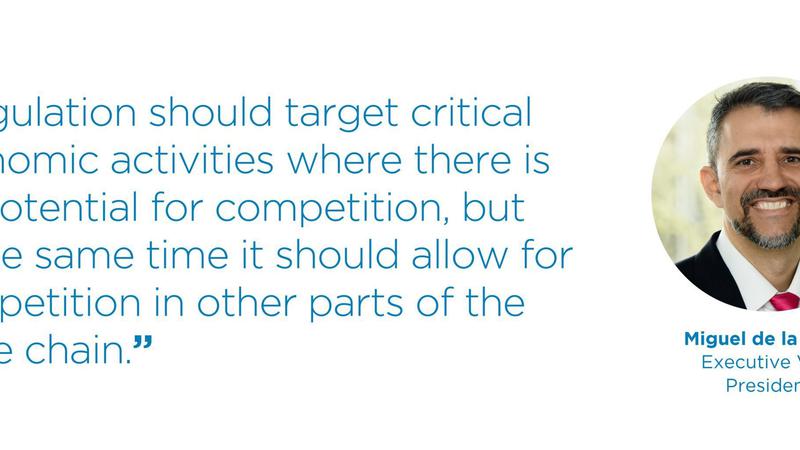Event Synposis: The Innovation Economics Conference for Antitrust Lawyers 2023

Share
On 13 June, Compass Lexecon partnered with Concurrences for the seventh Innovation Economics conference for antitrust lawyers at King’s College London. Senior Vice President, Patricia Lorenzo, spoke on the "Interaction between SEPs and Competition Law" panel, and Rashid Muhamedrahimov spoke on the "New Tools and Technologies: What impact for competition law?" panel.
This synthesis was originally published by Concurrences and is available on their website (subscription required). The views expressed are those of the authors only and do not necessarily represent the views of Compass Lexecon, its management, its subsidiaries, its affiliates, its employees, or clients.
Key Takeaways
Panel 2 - Interaction between SEPs and Competition Law
Senior Vice President, Patricia Lorenzo
Main competition concerns when it comes to SEPs
Patent hold up and patent hold out are two important concepts related to SEPs and competition law. A patent hold up situation arises when patent holders abuse their market power over users that cannot substitute the technology which is indispensable for competition. Patent holders can abuse their market power by charging excessive royalties. They can also foreclose competitors by seeking unjustified injunctions or by using anti-competitive pricing schemes. A patent hold situation arises when implementers are trying to “free ride”. They tend to get an advantage by not seeking licences or by offering inadequate terms before getting a potential agreement.What is usually done in practice in relation to FRAND determination
Then, one would determine what proportion of this aggregate royalty rate applies to the group of patents or a particular patent under reviewThe comparable approach
The comparable approach is the most commonly used by practitioners but it is also the most disputed one. This approach faces several challenges. The first challenge is to identify what is a comparable contract. From an economic perspective, comparability should be determined based on objective criteria related to the contract. The second challenge is that, due to confidentiality, information on past contracts is rarely available. There is a limited amount of information and the databases in the public domain do not always include suitable comparable transactions. Finally, a question arises on how to distinguish legitimate differences reflecting disparities in market conditions from discrimination.The implementation of the top down approach in practice
There are different views on how this approach should beimplemented in practice. From an economic perspective, it would be preferable to estimate the aggregate royalty rate as a fraction of the future incremental value generated by the application of the technology covered by the patent. This approach is sometimes referred to as the present value added approach. The main challenge is how to estimate consumer willingness to pay for the patent. It can be estimated (directly or indirectly) using historical data on prices and consumption or using survey techniques, such as choice modelling experiments. Survey techniques are particularly useful when real data is not available.The new proposal regulation
The new SEP regulation could contribute to alleviate some of the challenges. The creation of a transaction database is extremely positive on paper. The question is what proportion of the agreements are going to be registered and whether actors from the public and private domain will disclose useful information on those agreements. For example, information about the context of negotiations would be relevant. Other issues will be who is going to have access to this information and, consequently, will the database be more useful for the partiesPanel 3- New tools and technologies: What impact for competition law?
Head of Data Science, Rashid Muhamedrahimov
Addressing new tools and technologies from a private perspective
New tools and technologies focus on data collection, processing, and various advanced modelling techniques.
The main uses of these tools are to (a) improve efficiency and expedite competition law processes, and (b) provide new evidence in competition proceedings.
Diverse sources of evidence are explored to enable better decisionmaking by authorities and decision-makers. The goal is to make more informed and well-founded decisions.
On the efficiency side
Tools like web scraping have been employed to collect specific data types and ensure novel sources of data.
Novel types of analysis and evidence
In an EC phase II merger case in the hardware industry, the goal was to supplement market study information. The idea was to conduct a similar analysis using publicly available data to understand the industry’s opinion on the merger. Instead of manually labelling positive or negative views, they aimed for an automated approach for efficiency and epistemological purity.
Large Language Models were used to classify text as positive or negative, providing replicable and scalable results.
In another case, text analysis techniques like entity recognition and dependency parsing were employed to convert unstructured human sentences into numerical data. Using this dataset allowed for a detailed analysis of closeness of competition, which was used in addition to traditional evidence in competition cases.
A lot of the time the algorithms themselves are very complex, but they can provide very simple insights, and provide valuable supplements to the existing evidence base.
The use of these new tools to monitor compliance and reduce risks
Active data pipelines can be built to collect pricing decision-making data from various endpoints. The collected data is then centralised in a database for analysis.
Pricing algorithms and collusion
A lot of discussions about algorithms learning to collude is very highly academic in practice. To be able to deploy that in a production system would be way too impractical and expensive.
There is a potential legal question of how much of the algorithm do you need to understand to be liable.


